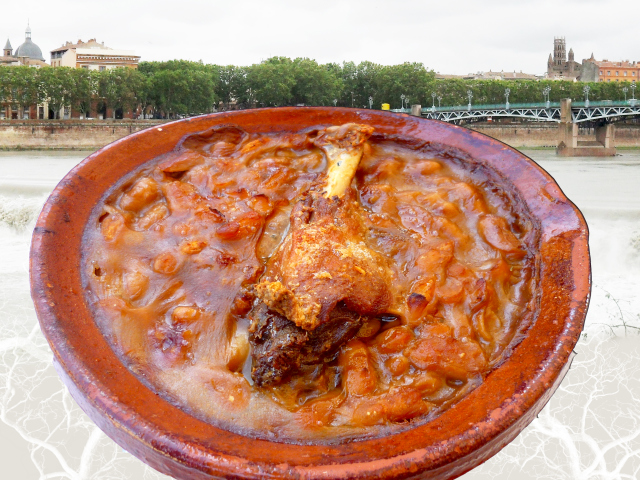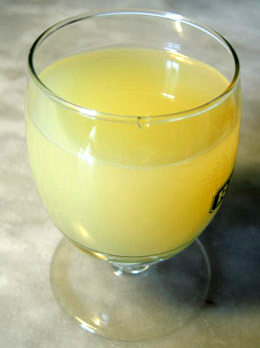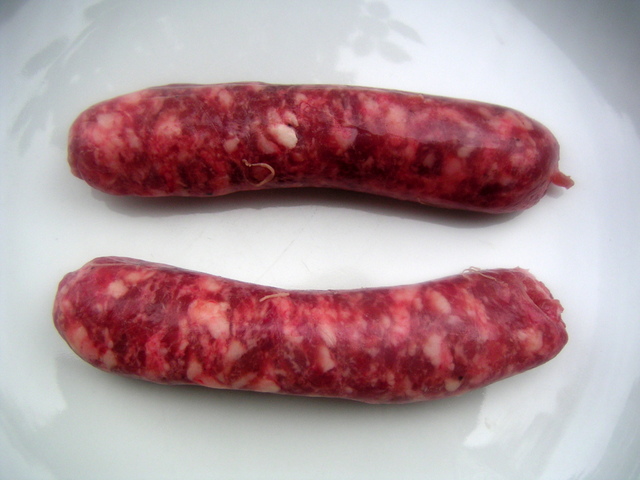The Toulouse Gastronomy is full of history, flavours, creativity and taste. If you are visiting the city of Toulouse or the region of Midi-Pyrénées, take the time to enjoy some of the traditional dishes or buy some regional produce. Midi-Pyrénées is a region proud of its 19 Michelin-starred chefs. You can stop into a bistro for a bite to eat, a coffee, buy a newspaper or sample a local dish. If you decide to cook for yourself, every town has wonderful markets twice a week to help you create the perfect dish with fresh produce.
Cassoulet

The Toulouse region has many culinary specialties including the Cassoulet. Legend has it that this meal comes from Castelnaudary, the self-proclaimed ‘Capital of Cassoulet’. The basis of the recipe is a white bean stew cooked for a long time in a “cassole”, a kind of earthenware dish, but in fact there are different types of Cassoulet, depending on the city where it is made. It is made with pork and leek in Castelnaudary, partridge and mutton in Carcassonne while it is made with onion, sausages and duck in Toulouse. There is great rivalry between the supporters of each region but Prosper Montagné, a former chef, tried to reconcile everybody with this great metaphor:
“The Cassoulet is the God of the Occitan cuisine, God the Father is the Cassoulet from Castelnaudary, God the Son the one from Carcassonne and the Holy Spirit is the one from Toulouse.”
Cassoulet toulousain is another dish which has to be made just right: haricots tarbais (beans from Tarbes) mixed with goose confit, pork knuckle, pork-rind sausage, herbs, garlic and nutmeg. It takes a long time to make and must be served in a little terracotta bowl. The lengthy preparation of a cassoulet begins with the soaking of the beans in cold water for 12 hours. The beans are then blanched for 5 minutes before being added to a pan with pork skins, ham knuckle, onion, carrot, a bay leaf and some thyme. The mixture is left to simmer for an hour. The bones and vegetables are then removed. The pork skins are chopped up with the garlic and the sausage is fried in fat duck, while the pork ribs are browned in lard with the chopped onion and carrot. Water is added and the ingredients are once again left to simmer slowly for another hour. Finally, the sausage, pork skins, beans and duck are placed in the cassole. The bowl is placed in a preheated oven at 375°F/190°C for another hour.
Garbure
![Garbure © Jean Michel Etchecolonea - licence [CC BY-SA 3.0] from Wikimedia Commons](https://frenchmoments.eu/wp-content/uploads/2014/02/Garbure-©-Jean-Michel-Etchecolonea-licence-CC-BY-SA-3.0-from-Wikimedia-Commons.jpg)
Among the region’s many culinary specialities, garbure is one dish that stands out. This Pyrenean speciality is a soup made with potatoes, cabbage, haricots tarbais beans and dried knuckle of ham. In fact, Auguste Escoffier has recorded nearly 3,000 different French recipes for this dish. The simplest recipe is the following one:
Firstly, add pork belly with carcass or bone and beans to the water, bring to the boil, skimming frequently. Then add the onion with cloves and turn down to a simmer for about an hour. Meanwhile take the leeks and onion and sweat down until softened, add to the soup along with the turnips, the bouquet garni and some salt and pepper. Leave to simmer for another 45 mins. Discard the carcass or bone, onion and cloves at this point. Now add the potatoes and the ‘jambon de campagne’, bring back to a boil then reduce to a simmer for 30 minutes. Finally add the confit and the cabbage, simmer for another 20-30 mins. You will know if it’s ready if a ladle stays upright! Remove the meat and a little of the juice, place in a pre-warmed platter and cover with foil to keep warm. Take some chunky slices of french bread, stale if possible, and line up your soup bowls. Now ladle the delicious, thick, soup onto the bread and serve as a starter. Serve the meat afterwards with cornichons or a salad.
The violet of Toulouse

The violet appeared in France under the emperor Napoleon III. The variety called “the Parm” was cultivated to the north of Toulouse. The authentic violet of Toulouse is a specific variety from the region, cultivated since the middle of the 19th century. It is recognisable by its dense double flower, bold violet colour and subtle and delicate fragrance. The violet is an integral part of Toulouse’s identity, has its own festival in winter and is available in a range of cosmetic products (soaps and eaux de toilette) and sweet treats (sweets, caramels and syrup for cocktails…).
The violet represents modesty, peace, gentleness, hidden love, humility, respect and timidity.
Purple is meant to remind a loved one that we think of her or him to enjoy love discreetly. As a symbol of true love, pure and sincere, the Violette de Toulouse is the choice of lovers. In fact, men were accustomed to declare their passion for their beloved with a bouquet of violets … We remember Luis Mariano, who sang “Love is a bouquet of purple violets…”
Pastis

Pastis is not only the name of a French aperitif from Marseille, but also the name of a dessert only made in Gascony. The Pastis is a brioche flavoured with orange blossom water and rum, sometimes Armagnac. The recipe for this superfine puff pastry is inherited from the 8th century Moors while on the road to Poitiers. From time to time, there are contests in some villages to find the best pastis. In some places, you can find it with another name: Croustade. It is really delicious served cold or warm and with a scoop of vanilla ice cream.
Find out more about Pastis here.
Cachou Lajaunie
![Cachou Lajaunie © Didier Descouens - licence [CC BY-SA 3.0] from Wikimedia Commons](https://frenchmoments.eu/wp-content/uploads/2014/02/Cachou-Lajaunie-©-Didier-Descouens-licence-CC-BY-SA-3.0-from-Wikimedia-Commons.jpg)
The cachou comes from the Areca Catechu (Betel nut palm), a tree found in East India producing betel nuts. The paste extracted from the nuts is then boiled and filtered and the result after evaporation is the cachou (black cutch). Its virtues are similar to nicotine: an appetite suppressant and a stimulant.
Reformulated by pharmacist Léon Lajaunie around 1880 in Toulouse as a breath freshener for smokers and for general oral hygiene, the cachou belies its size by packing a punch of flavour, thanks to a savvy combination of licorice, starch, sugar, black cutch and mint. Many of Lajaunie’s customers were looking for a solution to their bad breath and after many tests, the Cachou Lajaunie was born. The famous yellow round tin was designed by a clock-maker friend of Léon Lajaunie, M. Caire and then created by the Sirven brothers. Indeed, Lajaunie wanted to design a tin which would fit conveniently into a watch-pocket.
Léon Lajaunie was business savvy and marketed his product very well; he set up one the first in-store advertisements on an enamel sign. Later, the famous poster artist Leonetto Cappiello also designed beautiful signs for the Cachous. Léon Lajaunie’s efforts seem to have paid off after his first advertising campaign in 1890. The Cachous Lajaunie were an immediate success! In 1904 he sold the formula and brand to the Sirven family, who expanded the business even further. A few decades later, Cachous Lajaunie launched his first posters and then advertised on TV. In 1985, Cachou produced a three-second spot which was awarded “Second best TV advertisement” in France. The brand was bought by Kraft Foods in 1997.
For all these reasons, the Cachous Lajaunie have become a cultural icon and it looks like they are here to stay, with ten million of these little tins sold worldwide every year! That is to say: a tin every four seconds.
Toulouse sausage

The Toulouse sausage is usually braised or fried and is an important ingredient of the cassoulet from Toulouse. Toulouse sausages contain red wine, thyme, garlic, nutmeg and bacon. In order to have a perfect Toulouse sausage, you must marinate the pork in red wine for at least 24 hours before adding lashings of fresh garlic, fresh herbs and cracked black pepper. It is a rich, strong flavor with a distinctive aroma of garlic and red wine. Moreover, Toulouse sausage is also delicious with pasta, stirfries and salads or on the barbecue. However, the best way to smell and taste all the flavours it is to bake it in an oven.
Iconic Toulouse restaurants
Michel Sarran
Michel Sarran has created a timeless ambience in his manor house, adding elegant contemporary touches to a setting that is stylish without being fussy. This convivial atmosphere forms the backdrop for a fine culinary experience. Here, it is a house more than a restaurant, where the art of life is practised with sweetness, discretion and charm. Michel Sarran says “the word “customer” does not apply […] we are sellers of pleasure”. Listen to him when he says: “I want my cooking to have a taste, titillate, tickle the palate and if it can create some emotions then my objective is reached and the pleasure is shared”. And he speaks honestly when he says: “I like to achieve a Latin cooking, drawing my inspiration from my memory drawers, playing with lavender and violette, foie gras and parmesan, rougets and pumpkin, etc…”. Born in Saint-Martin d’Armagnac in the Gers, Michel Sarran shared his professional journey between the southwest and the Mediterranean coast before settling in Toulouse in 1995. This restaurant is one of the best tables in Toulouse and the Midi-Pyrénées with two-stars in the Guide Michelin (Red guide).
The chef’s suggestions
Ferme de la Cave duck foie gras in a just-warm Belon oyster soup; and
light mousse of Haricots Tarbais with aged rum, coconut milk and marrons glacés.
Chez Carmen
If you are a real red meat lover, this is the place to go in Toulouse. Situated in the front of the former slaughter houses of the city, which now comprise the Museum of Modern Art, Chez Carmen has the best quality meat in town. Indeed, back in the time Chez Carmen bought the freshest meat available from just across the street. If you’re wondering about trying steak tartare for the first time, do not hesitate at Chez Carmen. You can also order your meat and choose how many grams you want to eat with his homemade fries!
L’Amphitryon
The youngest starred chef in France, Yannick Delpech, welcomes you into his lovely restaurant l’Amphitryon near the aeronautical site. It is bright, contemporary and surrounded by greenery. His dishes are very fine and meticulous and while remaining firmly rooted in the French classics and the Southwest, they also show plenty of creativity. L’Amphitryon has had two stars in the Red guide since 2008. Twice a month, you can book a 2 hour cooking lesson in a professional kitchen with Yannick Delpech himself, preparing a complete meal, a wine degustation and lunch. The restaurant is somewhere between traditional and innovative and is in perfect harmony with the local gastronomy and “art de vivre”. Attractive, tasty and respectful: these are the three words Yannick uses to describe his cuisine, inspired by seasonal colours and his collaboration with local producers. The restaurant has three different decors to create three distinctive atmospheres : Air, Earth and Fire. As a true pastry chef at heart, the chef still loves to create desserts that feature an authentic taste and an intense aroma and open the door to the true essence of a plant, a fruit or a spice.
The chef’s suggestions
The Caviar des Pyrénées with sliced sardine served with cod crème and horseradish condiment or his Canette du Lauragais duckling en croûte with black pepper, coriander and cumin.
L’Entrecôte
In 1959, Paul Gineste de Saurs created Le relais de Venise in Paris and decided to serve a walnut salad with vinaigrette as the first course, then only one main dish – a traditional French bistro meal: steak-frites. The reputation of L’Entrecôte stems from its scrumptious top secret sauce. Thanks to his steak with sauce, his restaurant flourished and became an institution in Paris. Since then, his successors operate their groups of restaurants under slightly different names but keeping to the same formula. L’Entrecôte is very popular in Toulouse and you must line up for a table around 8:00pm each day. The friendly service, cheap prices and homemade fries make the difference.
Le Bibent
Since its re-opening in 2010, the chef Christian Constant has given a second life to the Bibent, translated as “good-drinking”, in Occitan. Located in the heart of the pink city, on Capitol place in the heart of Toulouse’s old town, his fantastic Belle Époque Brasserie is an architectural wonder. A mix of baroque and art nouveau, this special place of history takes you to 1890. Christian Constant is proud of his southwestern roots and after thirty years spent in Paris at the Ritz, the Crillon and many other fine restaurants, he has decided to head back down south. This Brasserie is the culmination of his career in a friendly atmosphere. Of course, like every other brasserie, you do not need a reservation, just push open the door if you want to be bewitched by the food and the decor. Here you can savour all the typical local and French dishes such as: cassoulet, mimosa eggs, veal head, tartare, duck’s liver hamburger, croque-monsieur and so many others.
English-French Vocabulary
(f) for féminin, (m) for masculin, (adj) for adjective and (v) for verbs
- bean = flageolet (m)
- chef = chef cuisinier (m)
- dish = plat (m)
- to eat = manger (v)
- gastronomy = gastronomie (f)
- restaurant = restaurant (m)
- sausage = saucisse (f)
- to savour = déguster (v)
- violet = violette (f)



